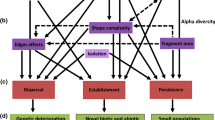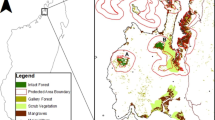Abstract
The effects of habitat fragmentation on species richness and composition have been extensively studied. However, little is known about how fragmentation affects functional diversity patterns. Fragmentation can indeed affect functional diversity directly (e.g. by promoting traits associated to long-distance dispersal when fragment isolation increases) or indirectly (e.g. by decreasing species richness, hence trait diversity, when fragment area decreases). Here, we used structural equation modeling to determine whether factors associated to forest fragmentation, namely area, habitat heterogeneity, spatial isolation and age have a direct effect on forest herb functional diversity. Using occurrence data from 243 forest fragments located in northern France and six plant life-history traits, we estimated species richness and calculated functional diversity in each of these 243 forest fragments. We found that species richness was the primary driver of functional diversity in these fragments, with a strong positive and direct relationship between species richness and functional diversity. Interestingly, both fragment isolation and age had a direct negative effect on functional diversity independent of their effects on species richness. Isolation selected life-history traits associated with long-distance dispersal, while age selected for life-history traits typical of forest habitat specialists. Isolated and/or older forest fragments are thus at greater risk of local species and functional extinctions, and hence making these forest fragments particularly vulnerable to future global changes.



Similar content being viewed by others
Abbreviations
- FRic:
-
Functional richness
- FDpg:
-
Petchey and Gaston's index of functional diversity
- SEM:
-
Structural equation model
References
Adler PB, White EP, Lauenroth WK, Kaufman DM, Rassweiler A, Rusak JA (2005) Evidence for a general species-time-area relationship. Ecology 86(8):2032–2039
Barber CB, Dobkin DP, Huhdanpaa H (1996) The Quickhull algorithm for convex hulls. ACM Trans Math Softw 22(4):469–483
Bertrand R, Lenoir J, Piedallu C, Riofrio-Dillon G, de Ruffray P, Vidal C, Pierrat JC, Gégout JC (2011) Changes in plant community composition lag behind climate warming in lowland forests. Nature 479(7374):517–520
Biswas SR, Mallik AU (2011) Species diversity and functional diversity relationship varies with disturbance intensity. Ecosphere 2(4):28–35
Cadotte MW, Carscadden K, Mirotchnick N (2011) Beyond species: functional diversity and the maintenance of ecological processes and services. J Appl Ecol 48(5):1079–1087
Chabrerie O, Loinard J, Perrin S, Saguez R, Decocq G (2010) Impact of Prunus serotina invasion on understory functional diversity in a European temperate forest. Biol Invasions 12(6):1891–1907
Chabrerie O, Jamoneau A, Gallet-Moron E, Decocq G (2013) Maturation of forest edges is constrained by neighbouring agricultural land management. J Veg Sci 24(1):58–69
Cook WM, Lane KT, Foster BL, Holt RD (2002) Island theory, matrix effects and species richness patterns in habitat fragments. Ecol Lett 5(5):619–623
Cornwell WK, Schwilk DW, Ackerly DD (2006) A trait-based test for habitat filtering: convex hull volume. Ecology 87(6):1465–1471
De Bello F, Lepš J, Sebastia MT (2006) Variations in species and functional plant diversity along climatic and grazing gradients. Ecography 29(6):801–810
Decocq G, Hermy M (2003) Are there herbaceous dryads in temperate deciduous forests? Acta Bot Gallica 150(4):373–382
Dzwonko Z, Loster S (1992) Species richness and seed dispersal to secondary woods in southern Poland. J Biogeogr 19(2):195–204
Ehrlén J, Eriksson O (2000) Dispersal limitation and patch occupancy in forest herbs. Ecology 81(6):1667–1674
Endels P, Adriaens D, Bekker RM, Knevel IC, Decocq G, Hermy M (2007) Groupings of life-history traits are associated with distribution of forest plant species in a fragmented landscape. J Veg Sci 18(4):499–508
Ernst R, Linsenmair KE, Roedel M-O (2006) Diversity erosion beyond the species level: dramatic loss of functional diversity after selective logging in two tropical amphibian communities. Biol Conserv 133(2):143–155
Flynn DFB, Gogol-Prokurat M, Nogeire T, Molinari N, Richers BT, Lin BB, Simpson N, Mayfield MM, DeClerck F(2009) Loss of functional diversity under land use intensification across multiple taxa. Ecol Lett 12(1):22–33
Gilliam FS (2007) The ecological significance of the herbaceous layer in temperate forest ecosystems. Bioscience 57(10):845–858
Girao LC, Lopes AV, Tabarelli M, Bruna EM (2007) Changes in tree reproductive traits reduce functional diversity in a fragmented Atlantic forest landscape. PLoS One 2(9):e908
Graae BJ (2000) The effect of landscape fragmentation and forest continuity on forest floor species in two regions of Denmark. J Veg Sci 11(6):881–892
Grime JP (2006) Trait convergence and trait divergence in herbaceous plant communities: mechanisms and consequences. J Veg Sci 17(2):255–260
Grime JP, Hodgson JG, Hunt R (1988) Comparative plant ecology: a functional approach to common British species. Unwin Hyman, London
Hanski I (1994) A practical model of metapopulation dynamics. J Anim Ecol 63(1):151–162
Hérault B, Honnay O (2005) The relative importance of local, regional and historical factors determining the distribution of plants in fragmented riverine forests: an emergent group approach. J Biogeogr 32(12):2069–2081
Hermy M, Verheyen K (2007) Legacies of the past in the present-day forest biodiversity: a review of past land-use effects on forest plant species composition and diversity. Ecol Res 22(3):361–371
Honnay O, Verheyen K, Butaye J, Jacquemyn H, Bossuyt B, Hermy M (2002) Possible effects of habitat fragmentation and climate change on the range of forest plant species. Ecol Lett 5(4):525–530
Honnay O, Jacquemyn H, Bossuyt B, Hermy M (2005) Forest fragmentation effects on patch occupancy and population viability of herbaceous plant species. New Phytol 166(3):723–736
Iriondo JM, Albert MJ, Escudero A (2003) Structural equation modelling: an alternative for assessing causal relationships in threatened plant populations. Biol Conserv 113(3):367–377
Jamoneau A, Sonnier G, Chabrerie O, Closset-Kopp D, Saguez R, Gallet-Moron E, Decocq G (2011) Drivers of plant species assemblages in forest patches among contrasted dynamic agricultural landscapes. J Ecol 99(5):1152–1161
Kirby KJ, Bines T, Burn A, Mackintosh J, Pitkin P, Smith I (1986) Seasonal and observer differences in vascular plant records from British woodlands. J Ecol 74(1):123–131
Kolb A, Diekmann M (2005) Effects of life-history traits on responses of plant species to forest fragmentation. Conserv Biol 19(3):929–938
Lack D (1976) Island biology illustrated by the land birds of Jamaica. University of California Press, Berkeley
Laliberté E, Legendre P (2010) A distance-based framework for measuring functional diversity from multiple traits. Ecology 91(1):299–305
Laliberté E, Wells JA, Declerck F, Metcalfe DJ, Catterall CP, Queiroz C, Aubin I, Bonser SP, Ding Y, Fraterrigo JM, Mcnamara S, Morgan JW, Merlos DS, Vesk PA, Mayfield MM (2010) Land-use intensification reduces functional redundancy and response diversity in plant communities. Ecol Let 13(1):76–86
Lepš J, de Bello F, Lavorel S, Berman S (2006) Quantifying and interpreting functional diversity of natural communities: practical considerations matter. Preslia 78(4):481–501
Mabry CM, Fraterrigo JM (2009) Species traits as generalized predictors of forest community response to human disturbance. For Ecol Manage 257(2):723–730
Matlack GR (1994) Plant-species migration in a mixed-history forest landscape in eastern North America. Ecology 75(5):1491–1502
Mayfield MM, Ackerly D, Daily GC (2006) The diversity and conservation of plant reproductive and dispersal functional traits in human-dominated tropical landscapes. J Ecol 94(3):522–536
Mori AS, Furukawa T, Sasaki T (2013) Response diversity determines the resilience of ecosystems to environmental change. Biol Rev 88(2):349–364
Mouchet MA, Villeger S, Mason NWH, Mouillot D (2010) Functional diversity measures: an overview of their redundancy and their ability to discriminate community assembly rules. Funct Ecol 24(4):867–876
Öckinger E, Schweiger O, Crist TO, Debinski DM, Krauss J, Kuussaari M, Petersen JD, Pöyry J, Settele J, Summerville KS, Bommarco R (2010) Life-history traits predict species responses to habitat area and isolation: a cross-continental synthesis. Ecol Lett 13(8):969–979
Petchey OL, Gaston KJ (2002) Functional diversity (FD), species richness and community composition. Ecol Lett 5(3):402–411
Petchey OL, Gaston KJ (2006) Functional diversity: back to basics and looking forward. Ecol Lett 9(6):741–758
Robinson RA, Sutherland WJ (2002) Post-war changes in arable farming and biodiversity in Great Britain. J Appl Ecol 39(1):157–176
Saunders DA, Hobbs RJ, Margules CR (1991) Biological consequences of ecosystem fragmentation- a review. Conserv Biol 5(1):18–32
Schleicher A, Biedermann R, Kleyer M (2011) Dispersal traits determine plant response to habitat connectivity in an urban landscape. Landscape Ecol 26(4):529–540
Schweiger O, Musche M, Bailey D, Billeter R, Diekoetter T, Hendrickx F, Herzog F, Liira J, Maelfait JP, Speelmans M (2007) Functional richness of local hoverfly communities (Diptera, Syrphidae) in response to land use across temperate Europe. Oikos 116(3):461–472
Shipley B (2000) Cause and correlation in biology: a user’s guide to path analysis, structural equations and causal inference. Cambridge University Press, Cambridge
Sydes C, Grime JP (1981) Effects of tree leaf litter on herbaceous vegetation in deciduous woodland: I Field investigations. J Ecol 69(1):237–248
Tilman D (1994) Competition and biodiversity in spatially structured habitats. Ecology 75(1):2–16
Valladares F, Niinemets Ü (2008) Shade tolerance, a key plant trait of complex nature and consequences. Annu Rev Ecol Evol Syst 39:237–257
Verheyen K, Honnay O, Motzkin G, Hermy M, Foster DR (2003) Response of forest plant species to land-use change: a life-history trait-based approach. J Ecol 91(4):563–577
Villéger S, Mason NWH, Mouillot D (2008) New multidimensional functional diversity indices for a multifaceted framework in functional ecology. Ecology 89(8):2290–2301
Wilcox BA, Murphy DD (1985) Conservtaion strategy - the effects of fragmentation on extinction. Am Nat 125(6):879–887
Wu J, Liu Z, Qian J (2013) Non-linear effect of habitat fragmentation on plant diversity: evidence from a sand dune field in a desertified grassland in northeastern China. Ecol Eng 54:90–96
Zipkin EF, Dewan A, Royle JA (2009) Impacts of forest fragmentation on species richness: a hierarchical approach to community modelling. J Appl Ecol 46(4):815–822
Acknowledgments
This work was conducted while G.S. was a postdoctoral associate and A.J. a PhD student, both funded by a grant from the ‘Conseil Régional de Picardie’, within the framework of the research project METAFOR.
Author information
Authors and Affiliations
Corresponding author
Electronic supplementary material
Below is the link to the electronic supplementary material.
Rights and permissions
About this article
Cite this article
Sonnier, G., Jamoneau, A. & Decocq, G. Evidence for a direct negative effect of habitat fragmentation on forest herb functional diversity. Landscape Ecol 29, 857–866 (2014). https://doi.org/10.1007/s10980-014-0022-2
Received:
Accepted:
Published:
Issue Date:
DOI: https://doi.org/10.1007/s10980-014-0022-2




